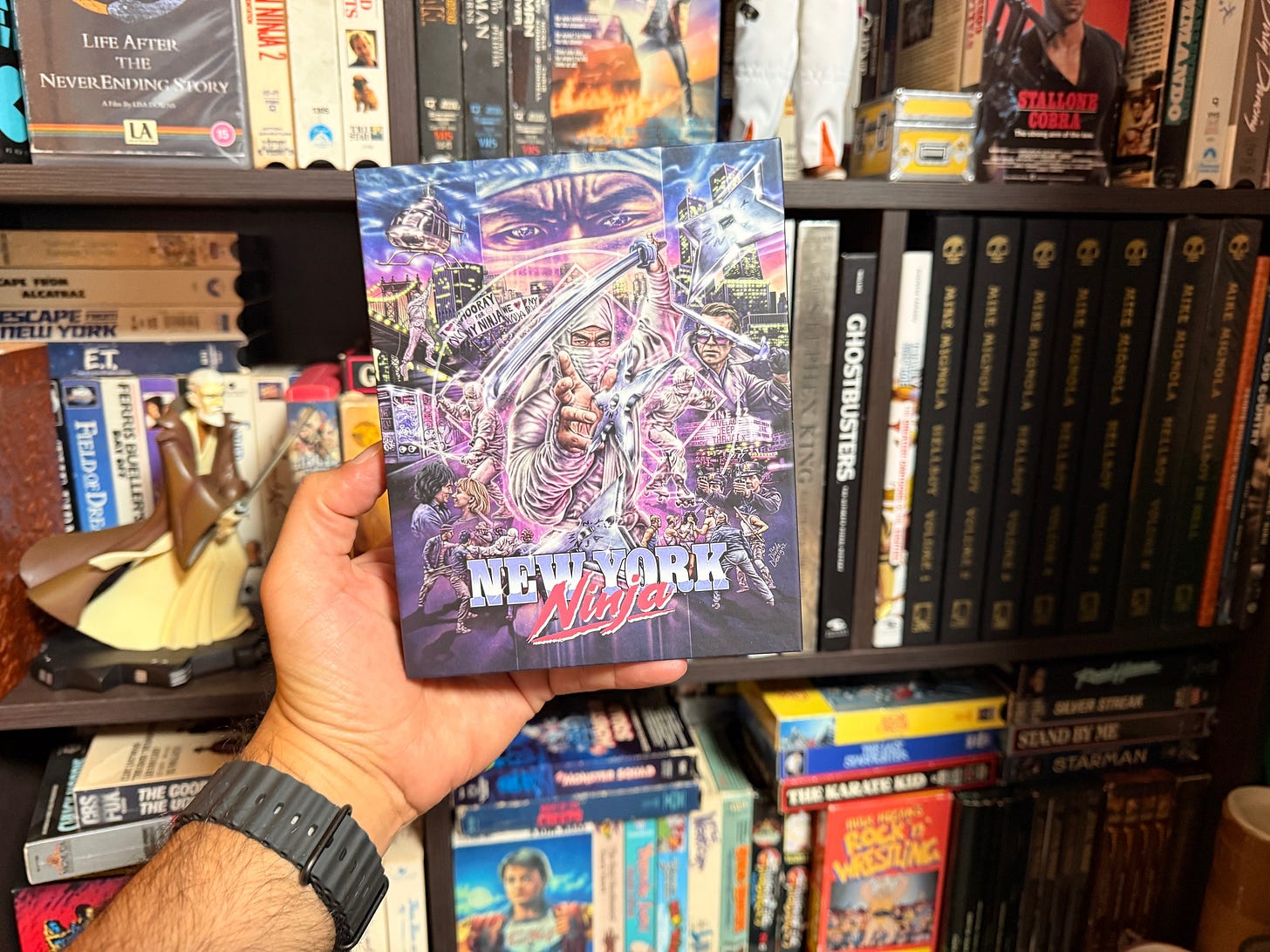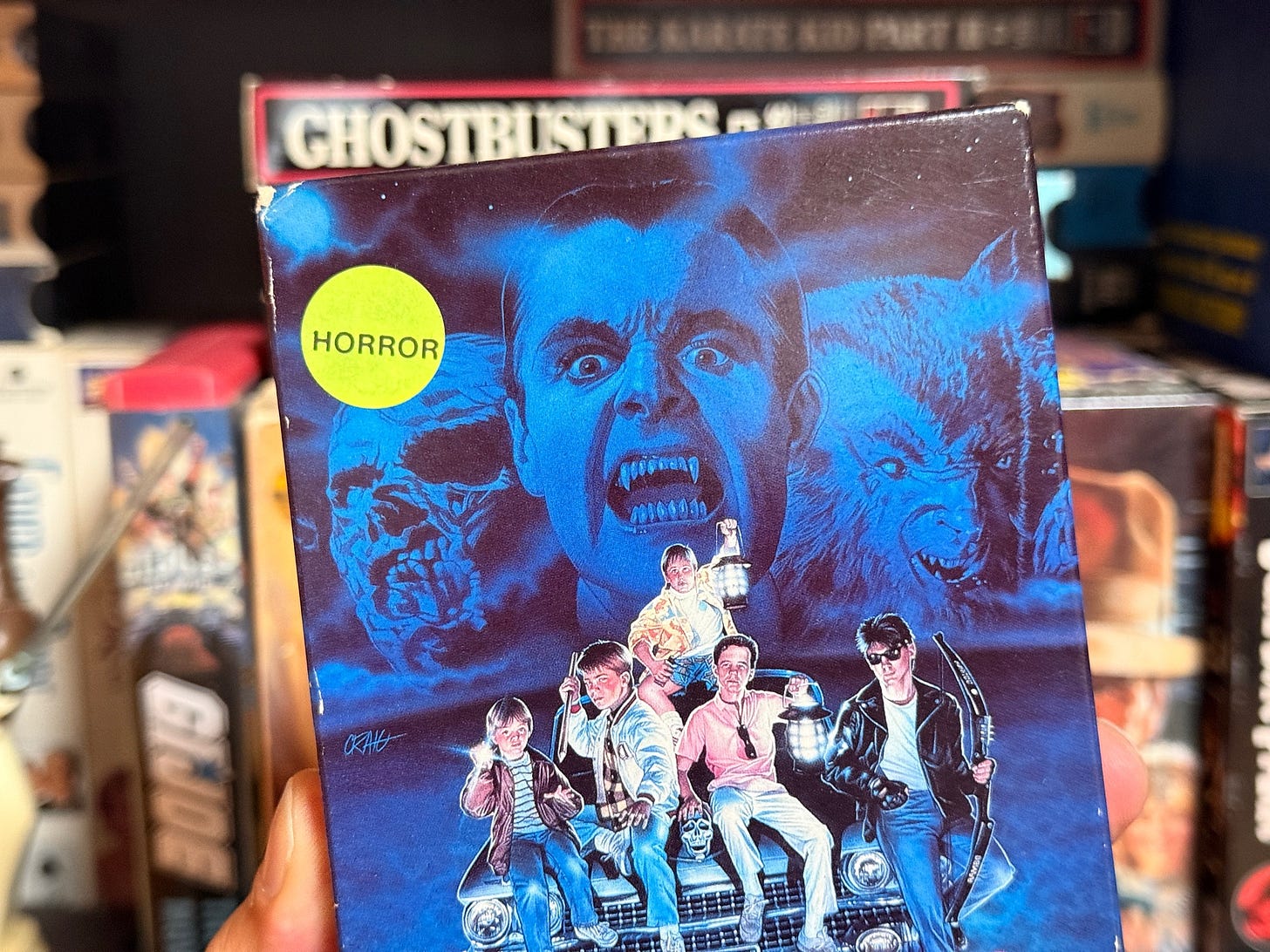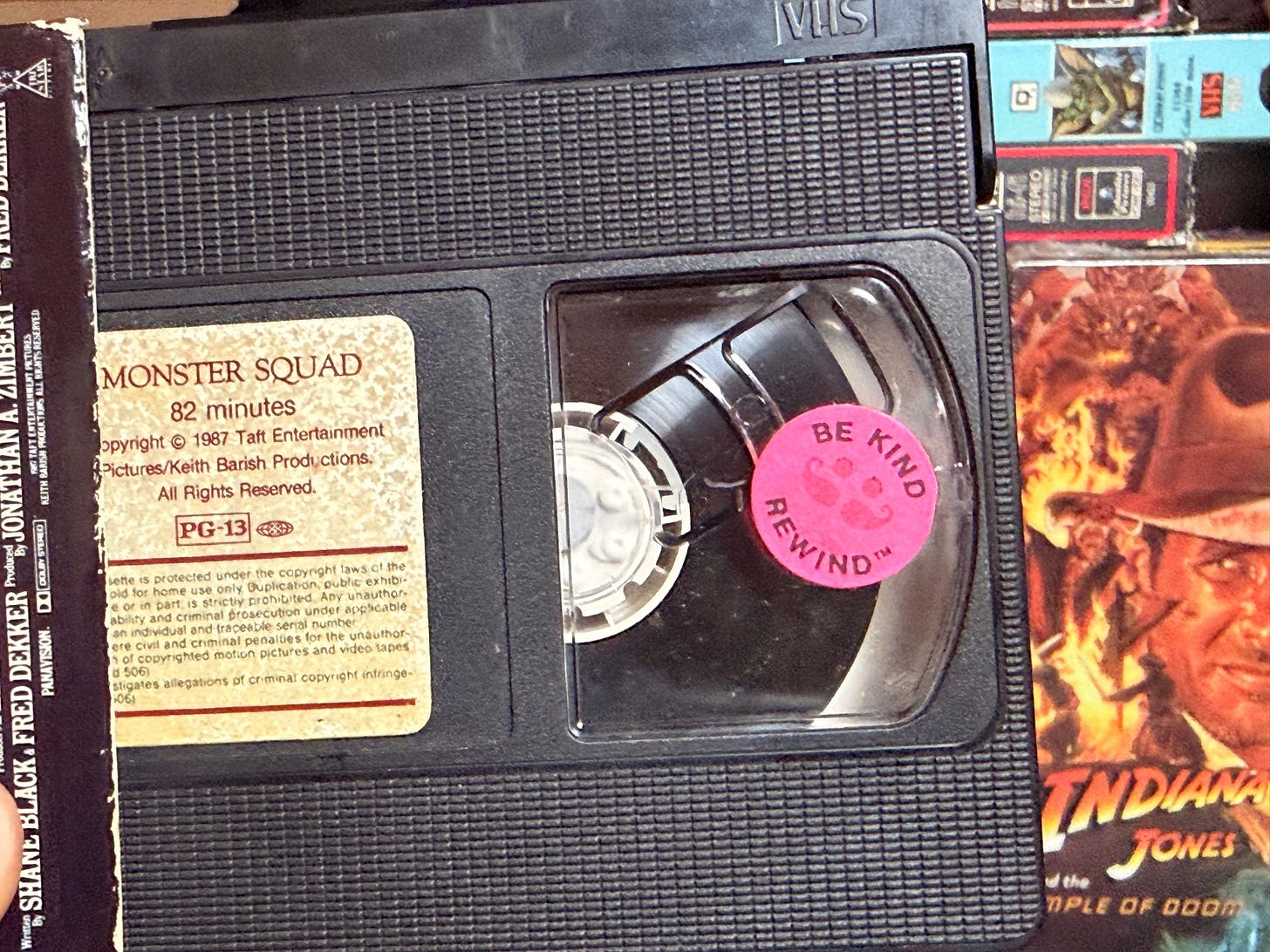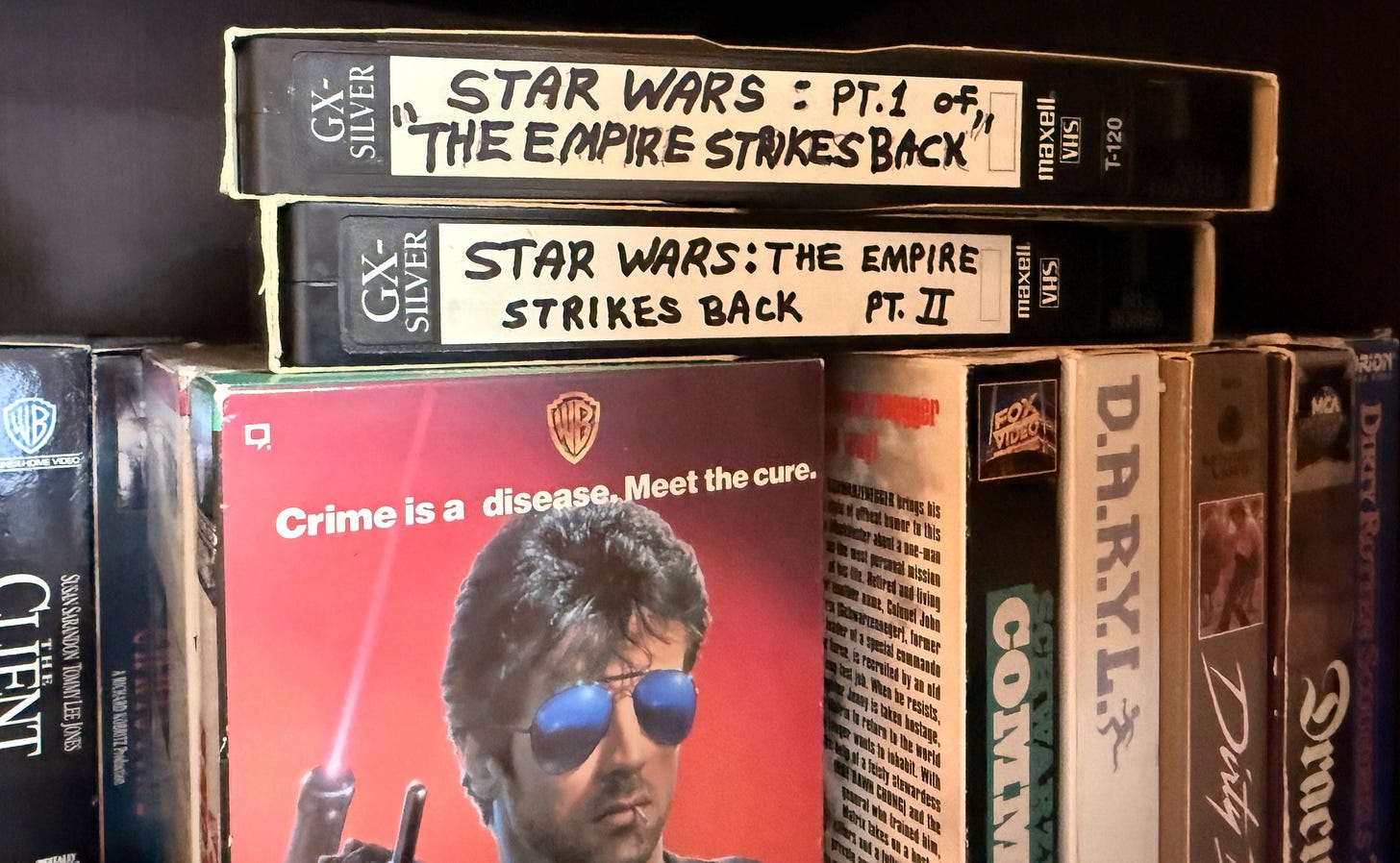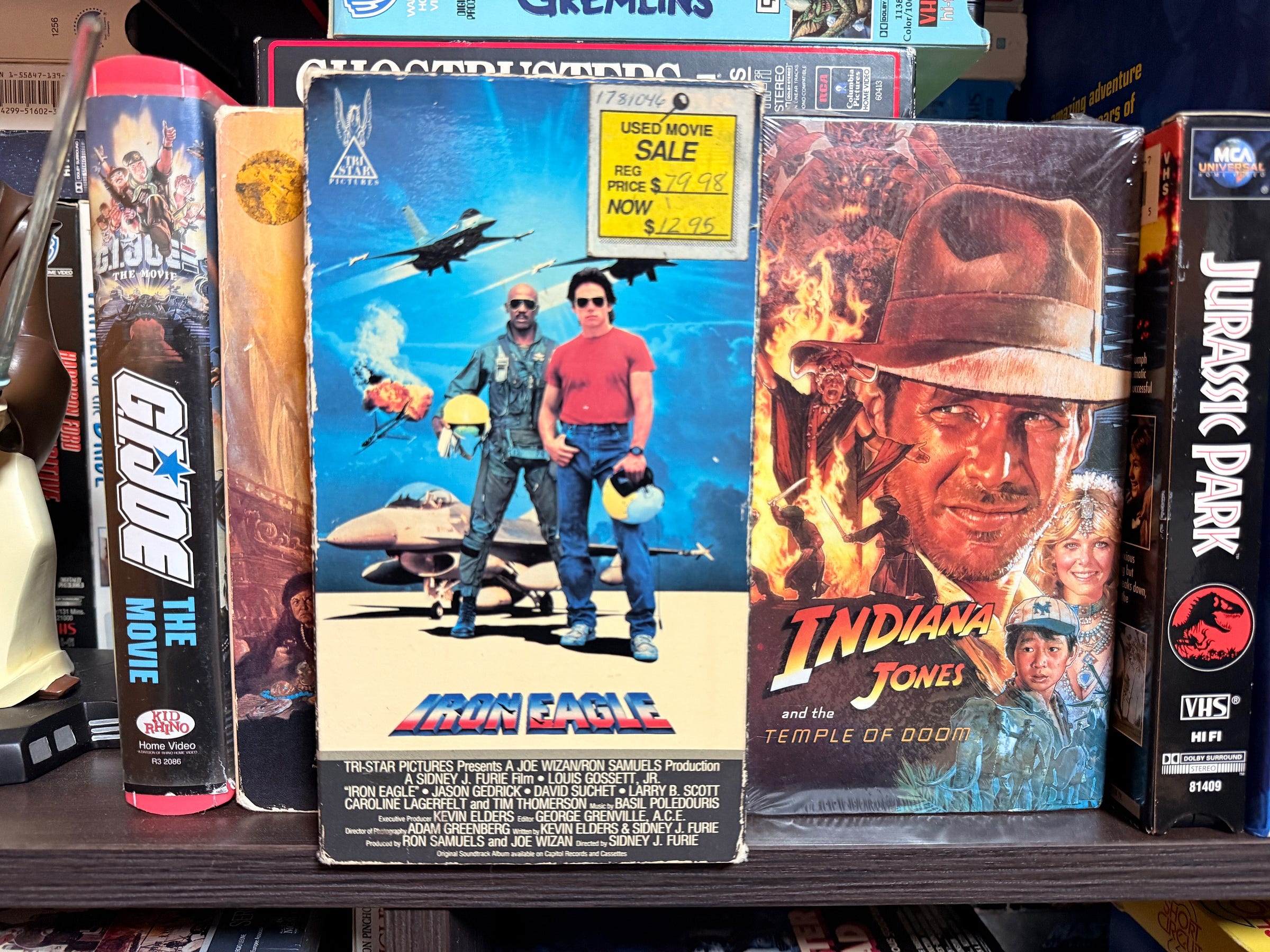Picture this…
It’s a late 1980-something, Friday night, and you’re staring at a bookshelf full of VHS tapes in your living room. Each cassette stands upright like a book, proudly displaying a spine label that you meticulously applied. Those spine label stickers were important markers in their own right. They were really your first attempt at being organized.
Now picture yourself at the video store. For Gen Xers, the sight of a “Be Kind, Rewind” decal or those fuzzy genre stickers take you back instantly, right?
The Home VHS Spine – A Library on Your Shelf
In the heyday of home video, VHS spine labels served as a personal library catalog. Once you recorded a TV show or brought home a new movie, the first order of business was often labeling the tape. A typical VHS label displayed the movie title, maybe a date, and any other notes to identify the content. This was vital. With dozens of tapes on the shelf, you needed to see at a glance whether a cassette was your Star Wars recording or last week’s Simpsons episodes, or a family video. Most blank VHS tapes came with sticker sheets for this purpose. There was the main label, also known as the “Top Label,” and then there was one long sticker for the spine. And let’s not forget the smaller stickers for tape length, such as T-60, T-120, or T-160, in case you were recording multiple programs and you wanted to make sure you had enough room on your tape.
For a lot of us, especially Gen X, creating those spine labels was more than a task, it was a ritual. Some of us had systems. I remember digging through sticker books, picking just the right one to slap on the side of a tape so I’d know exactly what was on it. Sometimes I’d use alphabet stickers to mark the order of a series. Like “V: The Series,” for example, where each volume got its own letter on the spine. It was part librarian, part mixtape DJ effort, and totally personal. Others simply scribbled titles by hand in marker, and others used pencil, often crossing out and rewriting as tapes were re-used or recorded over. The aesthetics varied widely. There were those that used label makers, which I think look pretty awesome on vhs. Organizing tapes by their spines made movie picking feel like pulling books from a shelf for me. It’s no surprise many of us feel nostalgia even for the look of those chunky VHS spines.
I have a respectable Blu-ray DVD collection and it’s really a shame that there was never really a systemized way to produce the exterior like with VHS. There are a few boutique production houses that release steelbooks and intricate and lovely dvd box sleeves, but I really wish there was a standard, similar to VHS, Cassette, and Vinyl. Most DVD cases are so thin they hardly allow any visible art or personality on the spine. With VHS, by contrast, the thick spine was a canvas for logos, artwork, or personal touches.
Genre Stickers and Colorful Design Tropes
Beyond home collections, video stores and tape distributors developed a visual language of their own for VHS packaging. Stroll through an old rental aisle in your memory, and you might recall the color-coded stickers shouting a tape’s genre or status. Many independent rental shops tagged each cassette with bright labels such as Horror, Comedy, Drama, Action, often in standardized colors for quick recognition. While each store’s scheme varied, it was common to see vivid red or orange stickers for horror films and something like yellow or blue for comedies, creating a really cool aesthetic on the shelves. These design tropes weren’t strict rules, but patterns emerged. Horror VHS covers themselves often featured black and red motifs, while family films used brighter, friendlier colors. Stores capitalized on that by adding their own bold spine labels and genre decals to make reshelving easier and guide customers (a neon “HORROR” sticker practically screaming “kids, put this one back!”). It was very common for mom and pop video stores to create cataloging systems and place labels on the spine area of the slip cover in order to locate a title. Back in the day when I purchased VHS tapes, I used to hate those labels because I thought they destroyed the box art. Today, however, I love the stickers because it adds character.
The major studios had signature spine designs that became familiar to collectors. Disney, for instance, famously packaged its classics in white plastic clamshell cases rather than the standard cardboard sleeves. This wasn’t just a quirk. Early VHS tapes were expensive luxuries (priced around $100 in the late 1970s and early 80s) and often came in sturdy cases to match that premium status. By the time sell-through prices dropped in the 90s, most studios switched to slim cardboard slipcovers, but Disney stuck to the clamshell for decades. As a result, the spines of Disney VHS tapes became literal outliers: taller, fatter, often with a bubbly font and the castle logo at the top. You either gave them their own row or let them awkwardly dominate the space because they were thicker and taller than most other vhs covers.
Meanwhile, other studios had their own trademarks. One of my favorites were the MGM/UA (United Artists) sleeves. These things were so cool because they were like opening a book cover. The vhs tape was nestled inside and it was an awesome experience to open. The only downside is that they definitely took up more space. Do you remember the consistent placement of logos like “CBS/Fox” or “Orion Home Video” at the tops of spines. RCA/Columbia Pictures was a great one because their spines had that distinctive red spine label around the title.
Collectors today can often identify a tape’s era or publisher just by that spine layout or the color schemes used on it. And let’s not forget some tapes had colored cassette shells as part of their aesthetic. For example, Nickelodeon released kids’ VHS tapes in bright orange plastic, and certain horror titles came in blood-red or black shells to stand out. What a wonderful visual time it was.
“Please Rewind” – Rental Stickers and Video Store Rituals
Anyone that rented a VHS in the 80s or 90s, and into the 2000s remembers the saying, “Be kind, Rewind.” Admit it, it is one of the most predominant and nostalgic things from that time that stands out to you as a practice of that time. This gentle rhyme was printed on countless stickers plastered to rental tapes. It was often accompanied by a smiley face or bold lettering. The “Be Kind, Rewind” sticker became a universally recognized plea. Why? Because many of us forget now that VHS tapes had to be manually rewound, and video stores cared dammit!
An unrewound tape meant the next customer (or a poor clerk) had to spend several extra minutes running it to the beginning. To encourage good behavior, rental shops deployed these stickers everywhere, and some even backed them up with fines. When I worked at Hollywood Video, we had about a dozen tape rewinders behind the desk because we never wanted to pass that task to the rental customer. It was store policy that every tape that arrived was rewound by staff if the customer that returned it forgot to rewind it. So yes, failing to rewind could hit you in the wallet depending where you rented from. This is where the infamous $2-Late-Fee was born from. Now, there are some of you out there right now that remember trying to rent a tape only to be told that you couldn’t rent one until the fee was paid. Shame on you!
Blockbuster’s sticker is probably the most notorious of them all because the tape label was cleverly designed to wrap around the front face and to the left side of a videotape, so that on one side showed a polite rewind reminder, and on the other side in bold capitals the word “WARNING!,” presumably threatening fees or charges if ignored.
Now, let’s talk about the arsenal of other ephemera rental stores deployed back in the day.
Do you remember the “3 Day Rental” or “New Release” stickers denoting how long you could keep a tape? There were all sorts of genre labels to direct you to the right shelf, and often a property sticker with the store’s name or an ID number. Many tapes rattled with a little magnetic security strip inside or had a holographic sticker that set off alarms. And woe to the person who tried to peel it off. Some ex-rental tapes still bear the scar of a label that threatened a hefty charge if tampered with. In fact, I remember seeing sticker that said something like, “$99.95 charge for tampering with this label,” which was a not-so-subtle way to deter theft or home recording. Another bit of security theater was the tamper-evident seal on the tape’s edge or the VHS case. This was common when purchasing a new tape, so you had to break the sticker to open the case, ensuring customers couldn’t swap out cassettes. And to prevent any recording over the store’s copy, most rental VHS cassettes had their record-protect tabs removed. In case you don’t recall, that was the little plastic piece on the cassette you normally had to break off to “lock” the tape from further recording. Some stores even covered the record hole with a sticker that would say “Void if Removed,” making it clear the tape was off-limits for recording. Some vhs blanks came with sticker sheets that included special dots meant to cover the record tab opening. In short, every sticker had a purpose. Stickers were a powerful way to manage the flow of tapes and protect the store’s investment.
The “Be Kind, Rewind” slogan itself is iconic, but there are other very important ones that exist, like the “Melt Sticker,” which has gained cult status among VHS aficionados. This was a label some shops placed on tapes to detect heat damage. If a customer left the tape in a hot car and the tape overheated, the sticker’s ink would change, essentially outing the negligent renter. It sounds crazy now, but at least a few stores went to that length to protect their stock. (Imagine returning a tape and the clerk pointing to a color-changed sticker and saying, “We know what you did to this poor VHS.”) These clever little innovations are mostly forgotten, but they highlight how VHS culture had its own ecosystem of care and concern, all expressed through stickers and labels.
Tiny Details with Big Nostalgia (Why Collectors Care)
It’s easy to chuckle at all this today. Who gets misty-eyed over labels? As it turns out, a lot of people do. Among VHS collectors and nostalgia buffs, the ephemera on a tape can be nearly as cherished as the movie itself. There’s even a gorgeous art book titled “Stuck on VHS: A Visual History of Video Store Stickers,” featuring over 1,000 images of old rental stickers and essays celebrating their place in pop culture. These seemingly trivial stickers are described as “small but essential ephemera” that captured a time when “movies mattered and video stores ruled.” In other words, they’re a tactile connection to an era.
Collectors debate fervently whether to leave vintage stickers on a tape or remove them. A 2017 Lunchmeat VHS article asked this very question to the “tapehead” community. Some purists see faded rental stickers as blemishes… ugly residues that mar the cover art. Others (myself included) view them as part of the tape’s story. As that article noted, many videophiles love these stickers because they “provide obscure insight on a tape’s origin” and add a “distinct bit of spice to their VHS collection.” A former Blockbuster tape without the Blockbuster sticker just isn’t the same; it’s like a passport without any stamps. Those stickers can tell you which store a tape came from, or even hint at the tape’s journey (imagine a well-worn “Property of Hollywood Video” label) How many living rooms did that tape travel through?.
For a lot of Gen X collectors, seeing an old video store label triggers instant memories of that store’s smell, the layout of the aisles, or the clerk who used to give you recommendations.
Collectors swap stories about weird finds online, like tapes covered in an overkill of labels, or humorous custom labels. In one Reddit forum, a user joked about creating a VHS label that “looks like a ransom note” using all those disparate letter stickers that came with blank tapes. Others recall family members who had almost librarian-like systems: one Redditor’s father numbered each tape and kept a movie notebook cross-referencing the contents. These personal anecdotes highlight how deeply people invested in organizing and labeling their media. It wasn’t just about finding a movie faster. I believe it was about taking pride in your collection and making it your own.
Forgotten Facts & Quirky Ephemera of the VHS Era
Let’s dig up a few unexpected or underappreciated facts about VHS labeling culture:
Rental VHS tapes were once outrageously expensive, often priced for rental shops only. In the early 1980s, a new movie on VHS might cost $80–$100, which is why stores went to great lengths to protect them. Those “tamper-proof” labels and hefty fine warnings weren’t hyperbole. A tape really could be worth that much. It also explains why early VHS releases came in elaborate packaging (big plastic clamshells or heavy cardboard boxes) to signify their value. By the late 80s, studios introduced lower-priced VHS for the mass market, and packaging became cheaper.
Blank VHS tapes included surprisingly granular labeling kits. If you ever bought a multi-pack of blank tapes, you likely found a sheet of stickers inside. Beyond the main spine and face labels, these sheets often had alphabet letters, numbers, and even tiny genre or TV-themed icons. Many users never touched those extra bits, but they were meant to let you do things like spell out a title vertically on the spine or mark volumes in a series (A, B, C… or 1, 2, 3…). Some brands threw in quirky stickers like “Sports,” or “Music,” anticipating how people might categorize their recordings.
Rental chain branding on spines: When Blockbuster took off in the late 80s, they introduced uniform branded cases and spine labels. Many of their VHS rentals didn’t display the movie’s original cover on the outside; instead, they came in a generic blue-and-yellow Blockbuster case. The spine of these cases had a simple text label with the movie title (often in Blockbuster’s stencil font) and an inventory number. Employees have described walls in the back room filled with black or clear cases, each with a white spine label, neatly numbered. So, while customers browsed the colorful box art on the shelves (typically just display cases or empty boxes), the actual tape you took home had a far more utilitarian look, a sort of secret second identity. Owning a former Blockbuster tape today, complete with that plain spine label and maybe a “Please Rewind” sticker, is oddly thrilling for collectors because it’s like a direct artifact of the Blockbuster experience. I have a few of these in my collection and they are so nostalgic to me. I was even sent a really cool Nintendo Switch game case from a modern gaming tech company that was designs to look like a Blockbuster vhs rental case.
Rewinding the Memories
As a Gen X kid and lifelong “tapehead,” reflecting on VHS spine labels and stickers is a trip equal parts nostalgia and insight. It’s funny how something so small, the spine label on a VHS tape, could play such a big role in our media lives. They were our map to countless movie marathons, a visual comfort in the era before endless digital menus. Culturally, they turned humble cassettes into conversation pieces and status symbols (think of the kid whose shelf of horror tapes was a rite of passage, each with red title fonts on the spines). Historically, these labels and stickers tell the story of a rapidly evolving home video industry, from the wild west of early rental clubs with their homemade tags, to the corporate polish of Blockbuster’s branding, and finally to the retro-obsessed collectors hunting for that rare “Melt Sticker” cassette today. Aesthetically, they form a lost art. The bold typography, colorful genre stickers, and even the wear-and-tear (faded highlighter marks, store stamps, peeled corners) give each tape a unique character.
In sharing these stories and details, I hope I’ve not only triggered some warm memories of your own (did you suddenly recall the exact look of your local video store?) But I also hope that I’ve highlighted why these tiny ephemera matter. They matter because they encapsulate a whole mode of living and enjoying media that was physical and communal. A VHS spine label could spark a conversation or a recommendation. A “Be Kind, Rewind” sticker taught us a little courtesy (and maybe responsibility). Even the silliest genre sticker or the most authoritarian warning label is now a marker of the past.
So here’s to those quirky spine labels, rental stickers, and tamper seals. Here’s to the unsung heroes of VHS culture. They may have been small, but they loom large in the memories of a generation. And if what mattered was taking the time to neatly label a cassette of our favorite show, or rewind a tape for the next person, maybe that says something good about us after all. In a world of instant access, we can appreciate the charm of when entertainment came with stickers and instructions.



